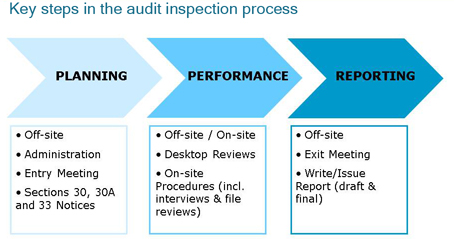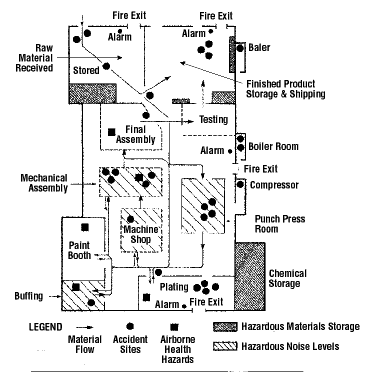General workplace pre-shift inspections:
- The inspections shall be conducted before work commences on the shift.
- Pre-shift inspection records will be maintained in the department and be subject to periodic audits by loss prevention.
- Correct deficiencies as they are observed, if possible.
- When deficiencies cannot be corrected on a prompt basis:
- Barricade and/or restrict access to unsafe areas until corrected.
- Report any hazardous conditions that cannot be immediately corrected to the supervisor prior to starting work activities.
- Responsibility for corrective action of identified hazards rests with the supervisor, foreman/manager, and finally the Health and Safety Manager.
Audit inspections are important as they allow you to:
- listen to the concerns of workers and supervisors
- gain further understanding of jobs and tasks
- identify existing and potential hazards
- determine underlying causes of hazards
- recommend corrective action
- monitor steps are taken to eliminate hazards or control the risk (e.g. engineering controls, administrative controls, policies, procedures, personal protective equipment)

Plan for the Inspection
Plan for inspections: - Planning is essential for an effective inspection.
What to examine: - Every inspection must examine who, what, where, when and how. Pay particular attention to items that are or are most likely to develop into unsafe or unhealthy conditions because of stress, wear, impact, vibration, heat, corrosion, chemical reaction or misuse. Include areas where no work is done regularly, such as parking lots, rest areas, office storage areas and locker rooms.
Look at all workplace elements – the people, the environment, the equipment and the process. The environment includes such hazards as noise, vibration, lighting, temperature, and ventilation. Equipment includes materials, tools and apparatus for producing a product or a service. The process involves how the worker interacts with the other elements in a series of tasks or operations.
Types of workplace hazards include:
Safety hazards such as those caused by inadequate machine guards, unsafe workplace conditions, and unsafe work practices.
Biological hazards are caused by organisms such as viruses, bacteria, fungi and parasites.
Chemical hazards are caused by a solid, liquid, vapour, gas, dust, fume or mist.
Ergonomic hazards are caused by physiological and psychological demands on the worker, such as repetitive and forceful movements, awkward postures arising from improper work methods, and improperly designed workstations, tools, and equipment.
Physical hazards are caused by noise, vibration, energy, weather, heat, cold, electricity, radiation and pressure.
Psychosocial hazards that can affect the mental health or well-being such as overwork, stress, bullying, or violence.
Click here to view an explanation of the main types of workplace hazards.
Information Needed to Complete An Audit Inspection Report
Diagram of Area
Use drawings of the plant layout or floor plans to help you draw a diagram. Divide the workplace into areas based on the process. Visualize the activities in the workplace and identify the location of machinery, equipment and materials. Show the movement of material and workers, and the location of air ducts, aisles, stairways, alarms and fire exits. Appendix A shows a sample diagram. Use several simple diagrams if the area is large. Ask workers and supervisors for their comments on the information - they know the area better than anyone else.
Equipment Inventory
Know what type of machinery or equipment is present. Review technical data sheets, or manufacturers' safety manuals. Read work area records to become familiar with the hazards of the equipment.
Hazardous Product or Chemical Inventory
Determine which products are used in the workplace and whether safety data sheets are available. Find out if all sources of exposure are properly controlled. Make sure that all workers have received education and training in how to safely use, handle and store the products they work with. Check that all hazardous products are labelled appropriately according to Workplace Hazardous Materials Information System (WHMIS) requirements.
Checklists
A checklist helps to clarify inspection responsibilities, controls inspection activities and provides a report of inspection activities. Checklists help with the on-the-spot recording of findings and comments. Use checklists only as a basic tool.
Refer to the related documents for sample checklists that you can use as a guide to developing a checklist that is customized for your workplace.
Inspection Checklists - General Information
Inspection Checklists - Sample Checklist for Manufacturing Facilities
Inspection Checklists - Sample Checklist for Offices
Inspection Checklist - Sample Checklist for Chemical or Product Inventory
Inspection Checklist - Sample Checklist for Outdoor Areas
Reports
Keeping inspection audit records is important. Past audit inspection records show what has been previously identified. They also show what an earlier inspection team concentrated on and what areas it did not inspect. Do not simply repeat or copy previous inspection results. Use the older inspection reports to help look for issues, and then determine whether recommendations were implemented. Note if the changes have been effective.
